
Anthozoa is a class of marine invertebrates which includes the sea anemones, stony corals and soft corals. Adult anthozoans are almost all attached to the seabed, while their larvae can disperse as part of the plankton. The basic unit of the adult is the polyp; this consists of a cylindrical column topped by a disc with a central mouth surrounded by tentacles. Sea anemones are mostly solitary, but the majority of corals are colonial, being formed by the budding of new polyps from an original, founding individual. Colonies are strengthened by calcium carbonate and other materials and take various massive, plate-like, bushy or leafy forms.

Scleractinia, also called stony corals or hard corals, are marine animals in the phylum Cnidaria that build themselves a hard skeleton. The individual animals are known as polyps and have a cylindrical body crowned by an oral disc in which a mouth is fringed with tentacles. Although some species are solitary, most are colonial. The founding polyp settles and starts to secrete calcium carbonate to protect its soft body. Solitary corals can be as much as 25 cm (10 in) across but in colonial species the polyps are usually only a few millimetres in diameter. These polyps reproduce asexually by budding, but remain attached to each other, forming a multi-polyp colony of clones with a common skeleton, which may be up to several metres in diameter or height according to species.

Pillar coral is a hard coral found in the western Atlantic Ocean and the Caribbean Sea. It is the only species in the monotypic genus Dendrogyra. It is a digitate coral -that is, it resembles fingers or a cluster of cigars, growing up from the sea floor without any secondary branching. It is large and can grow on both flat and sloping surfaces at depths down to 20 m (65 ft). It is one of the few types of hard coral in which the polyps can commonly be seen feeding during the day.

Porites astreoides, commonly known as mustard hill coral or yellow porites, is a colonial species of stony coral in the family Poritidae.
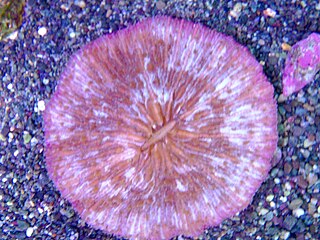
Pleuractis paumotensis, commonly called plate coral, is a species of stony coral with a single large polyp. Plate coral are commonly kept in marine aquaria.

Galaxea fascicularis is a species of colonial stony coral in the family Euphylliidae, commonly known as octopus coral, fluorescence grass coral, galaxy coral among various vernacular names.

Eusmilia is a genus of stony coral in the family Meandrinidae. It is a monotypic genus represented by the species Eusmilia fastigiata, commonly known as the smooth flower coral. It is found on reefs in the Caribbean Sea.

Siderastrea radians, also known as the lesser starlet coral or the shallow-water starlet coral, is a stony coral in the family Siderastreidae. It is found in shallow parts of the western Atlantic Ocean as small, solid mounds or encrusting sheets.
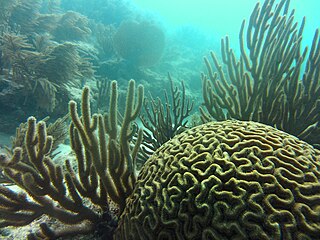
Pseudodiploria strigosa, the symmetrical brain coral, is a colonial species of stony coral in the family Mussidae. It occurs on reefs in shallow water in the West Atlantic Ocean and Caribbean Sea. It grows slowly and lives to a great age.
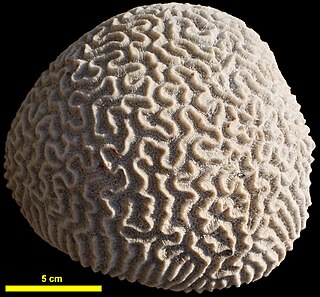
Pseudodiploria clivosa, the knobby brain coral, is a colonial species of stony coral in the family Mussidae. It occurs in shallow water in the West Atlantic Ocean and Caribbean Sea.

Meandrina meandrites, commonly known as maze coral, is a species of colonial stony coral in the family Meandrinidae. It is found primarily on outer coral reef slopes in the Caribbean Sea and the Gulf of Mexico.

Acropora secale is a species of branching staghorn stony coral. It is found in shallow parts of the Indo-Pacific Ocean and the type locality is Sri Lanka. The oldest fossils found date back to the Pleistocene.
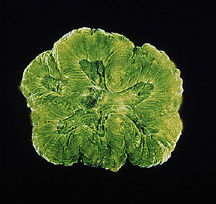
Isophyllia sinuosa, the sinuous cactus coral, is a species of stony coral in the family Mussidae. It is found in shallow water in the tropical western Atlantic and the Caribbean Sea.
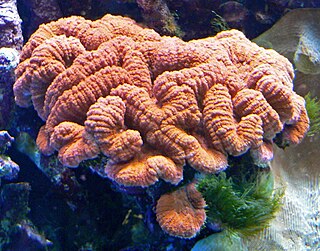
Lobophyllia hemprichii, commonly called lobed brain coral, lobed cactus coral or largebrain root coral, is a species of large polyp stony coral in the family Lobophylliidae. It is found in the Indo-Pacific Ocean. In its specific name Christian Gottfried Ehrenberg honoured his late partner the Prussian naturalist Wilhelm Hemprich; they were among the first to study the marine life of the Red Sea.

Favites pentagona is a species of stony coral in the family Merulinidae, sometimes known as larger star coral. It is native to the Indo-Pacific region and its range extends from the Red Sea through the Indian Ocean to the Western Pacific Ocean. This is a common species throughout its wide range and the International Union for Conservation of Nature has rated its conservation status as being of "least concern".
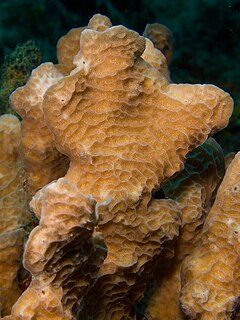
Agaricia agaricites, commonly known as lettuce coral or tan lettuce-leaf coral, is a species of colonial stony corals in the family Agariciidae. This coral is found in shallow waters in the tropical western Atlantic Ocean and the Caribbean Sea. It is a common species and the IUCN has assessed its status as being of "least concern".

Favites complanata is a species of stony coral in the family Merulinidae, sometimes known as the larger star coral. It is native to the Indo-Pacific region and its range extends from the Red Sea and Indian Ocean to the western and central Pacific Ocean. This is an uncommon species of coral and seems to be decreasing in abundance, and the International Union for Conservation of Nature has rated its conservation status as being "near threatened".

Blastomussa wellsi is a species of large polyp stony coral. It is unclear in which family the genus Blastomussa belongs. This coral is found in the west and central Indo-Pacific region.
Porites branneri, known by the common name blue crust coral, is a species of stony coral in the family Poritidae. It is found growing on reefs in the Caribbean Sea and the northern and eastern coasts of South America.
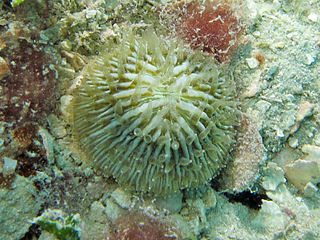
Cycloseris cyclolites is a species of disc coral in the family Fungiidae. It was first described by the French naturalist Jean-Baptiste Lamarck in 1815. It is native to the tropical and subtropical Indo-Pacific region where it is found on soft sediment in shallow water.





















